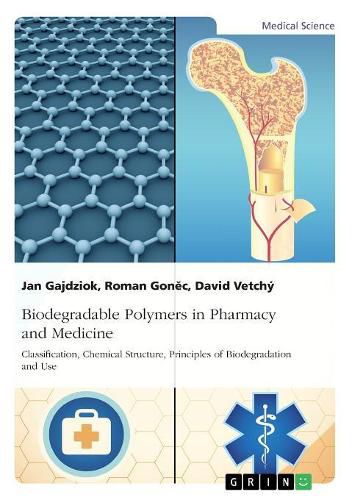Readings Newsletter
Become a Readings Member to make your shopping experience even easier.
Sign in or sign up for free!
You’re not far away from qualifying for FREE standard shipping within Australia
You’ve qualified for FREE standard shipping within Australia
The cart is loading…






Document from the year 2016 in the subject Medicine - Pharmacology, course: Pharmaceutical technology, language: English, abstract: The aim of this book is to provide a brief but comprehensive overview on the issue of biodegradable polymers. The introduction chapter is followed by a description of the general characteristics of biodegradable polymers and pathways of their degradation in the human body. Particular pitfalls and specifics of their various biomedical and pharmaceutical applications, especially in the field of pharmaceutical technology, are described in order to define the ideal carrier polymer system for specific types of therapy. Finally, the work presents the classification of these polymers based on the type of degradation mechanism. This section also includes the chemical structure of particular polymer molecules, their chemical or bio-synthesis and the description of their uses in specific biomedical and pharmaceutical applications. The book could be used as a textbook for students of medical and pharmaceutical sciences as well as by researchers in this field or industrial area. In the past few decades, biodegradable polymers have reached significant importance in fields of biomedical and pharmaceutical applications. They have become preferred candidates for the manufacture of therapeutic forms, for instance, orthopaedics devices, temporary bone screws and spins, three-dimensional scaffolds for tissue engineering or drug delivery systems for sustained and targeted release. Each of these applications requires material with specific physical, biological, and chemical properties, as well as specific degradation profile. These polymers (natural or synthetic) undergo hydrolytic or enzymatic degradation, which both have some advantages and disadvantages. Most widely used polymer materials in biomedical applications are listed, including their structure and degradation pathways.
$9.00 standard shipping within Australia
FREE standard shipping within Australia for orders over $100.00
Express & International shipping calculated at checkout
Document from the year 2016 in the subject Medicine - Pharmacology, course: Pharmaceutical technology, language: English, abstract: The aim of this book is to provide a brief but comprehensive overview on the issue of biodegradable polymers. The introduction chapter is followed by a description of the general characteristics of biodegradable polymers and pathways of their degradation in the human body. Particular pitfalls and specifics of their various biomedical and pharmaceutical applications, especially in the field of pharmaceutical technology, are described in order to define the ideal carrier polymer system for specific types of therapy. Finally, the work presents the classification of these polymers based on the type of degradation mechanism. This section also includes the chemical structure of particular polymer molecules, their chemical or bio-synthesis and the description of their uses in specific biomedical and pharmaceutical applications. The book could be used as a textbook for students of medical and pharmaceutical sciences as well as by researchers in this field or industrial area. In the past few decades, biodegradable polymers have reached significant importance in fields of biomedical and pharmaceutical applications. They have become preferred candidates for the manufacture of therapeutic forms, for instance, orthopaedics devices, temporary bone screws and spins, three-dimensional scaffolds for tissue engineering or drug delivery systems for sustained and targeted release. Each of these applications requires material with specific physical, biological, and chemical properties, as well as specific degradation profile. These polymers (natural or synthetic) undergo hydrolytic or enzymatic degradation, which both have some advantages and disadvantages. Most widely used polymer materials in biomedical applications are listed, including their structure and degradation pathways.